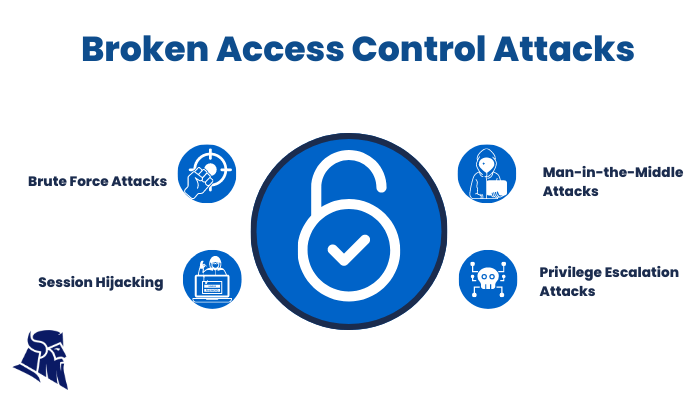Contents:
What Is Broken Access Control?
Broken access control is a type of vulnerability that allows unauthorized users to gain access to sensitive data or systems. This can happen when controls such as authentication and authorization are not properly implemented, or when there are weaknesses in the way these controls are enforced.
Without proper privileged access management practices implemented, broken access control can lead to several serious security issues, including data breaches, theft of sensitive information, and loss of system availability.
In some cases, it can also enable an attacker to gain elevated privileges that allow them to perform malicious actions on the systems or data they have accessed.
Organizations need to be aware of the risks posed by broken access control and take steps to prevent it. This includes ensuring that all controls are properly implemented and enforcing least privilege principles to limit the permissions of users and groups.
Additionally, regular monitoring of systems and data should be conducted to detect any unauthorized activity.
Types of Broken Access Control Vulnerabilities
There are four common types of broken access control vulnerabilities:
Insecure Direct Object References
This type of vulnerability occurs when an application exposes a direct reference to an internal object, such as a file or database record. By manipulating the reference, an attacker can gain unauthorized access to the object.
Lack of Restriction on URL Parameters
Many applications use URL parameters to control access to resources. However, if these parameters are not properly restricted, an attacker can manipulate them to gain unauthorized access.
Mass Assignment
This type of vulnerability occurs when an application allows users to input data that is used to automatically populate internal objects. If the data is not properly sanitized, an attacker can inject malicious code that will be executed when the object is accessed.
Security Misconfiguration
This type of vulnerability occurs when an application has improperly configured security settings, such as weak passwords or leaving debug mode enabled in a production environment. An attacker can exploit these misconfigurations to gain unauthorized access to sensitive data or systems.
Attackers may exploit these vulnerabilities to gain unauthorized access to sensitive data or make changes to data without the proper permissions. Organizations should implement adequate security controls to mitigate the risk cause by these vulnerabilities.
Broken Access Control Attacks
As the security landscape continues to evolve, so do the types of attacks that malicious actors use to gain access to confidential or restricted data.

Broken access control attacks can take many different forms, but they all have one thing in common: they allow attackers to bypass or circumvent the normal security controls that are in place. Some of the most common examples include:
- Brute Force Attacks – This type of attack involves repeatedly trying to guess a user’s password or other authentication credentials in order to gain access to their account.
- Session Hijacking – This attack occurs when threat actors take over a legitimate user’s session by stealing their session ID or cookies.
- Man-in-the-Middle Attacks – In this type of attack, the attacker intercepts communications between two parties and impersonates each party to the other.
- Replay Attacks – Here, the attacker captures and then later replays a valid authentication request in order to gain access to resources that they would not normally have access to.
- Privilege Escalation Attacks – Privilege escalation, like any cyberattack, takes advantage of flaws in network services and applications, especially those with weak access control systems.
How to Identify Broken Access Control Vulnerabilities
As we established by now, broken access control allows unauthorized users to gain access to sensitive information or systems. It can occur when there are weak or no controls in place to prevent unauthorized access, or when existing controls are not properly enforced.
There are several ways to identify broken access control vulnerabilities:
- Reviewing system and application logs for unauthorized access attempts.
- Conducting security audits of systems and applications.
- Testing systems and applications for known vulnerabilities.
- Using security tools like intrusion detection/prevention systems (IDS/IPS) and web application firewall (WAF) to monitor for and block unauthorized access attempts.
Best Practices and Prevention
As the world increasingly shifts to a digital landscape, organizations must take steps to protect themselves from broken access control. Once the vulnerabilities have been identified, they can be prevented by implementing strong authentication and authorization controls. This includes using strong passwords, two-factor authentication, least privilege principles, and proper segregation of duties.
There are some best practices that organizations can follow to help mitigate the risk:
1. Implement the Principle of Least Privilege (POLP)
The principle of least privilege (POLP) is a cybersecurity approach that has become simply the default setting for effective, modern security over the last years.
It means giving access to all sensitive information and critical systems on a strictly ‘need-to-have’ basis, with the goal of reducing service and user access permissions to the lowest possible amount.
POLP became increasingly important for modern cybersecurity due to the increasing complexity of IT environments. Organizations nowadays are likely to use a whole range of different distributed assets and systems, making modern cybersecurity uniquely challenging. Applying effectively the POLP can help organizations in achieving an effective cybersecurity strategy that’s properly tailored to defend them against modern threats.
2. Segment Your Network
Also known as network partitioning or network isolation, network segmentation is the process of dividing a network into smaller subnets.
By dividing the network into discrete, confined sections, you can successfully avoid a single point of failure and make it more difficult for malicious actors to compromise your company’s whole network.
3. Use Multi-Factor Authentication
Multi-factor authentication is an extra layer of security that requires users to provide additional information beyond just a username and password. This can help to verify a user’s identity, thus preventing unauthorized access.
Additionally, it’s important to regularly review and monitor logs for suspicious activity, and to patch systems and applications as soon as new updates become available. By following these best practices, organizations can help to protect themselves from broken access control attacks.
How Can Heimdal® Help?
Choosing the right technology to help you in keeping your organization safe is an important decision to make, especially considering the complexity of the threat landscape.
When it comes to privileged access management, one of the biggest dangers is highly manual processes. If the process is manual, there’s a high chance of error – and that’s where you see the biggest breaches. In the highest profile cases, you constantly see the targets being users with privileges they shouldn’t have.
Mikkel Pederson, Head of Global Sales Enablement, Heimdal®
That’s where Heimdal® with its Privileged Access Management solution comes in, giving you the tools you need to:
- Manage access permissions on endpoints and desktops
- Execute zero-trust policies across all systems
- Create customizable realtime access-blocking policies
- Enable just-in-time access
- Manage role-based access controls and delegation policies from one central window
Heimdal is light weight. Very little impact on system resources. The other thing though is it’s “quiet” … it works in the background helping to sheild from threats without interfering with your work with dialog boxes.
Heimdal® User Review from G2

Heimdal® Privileged Access Management
- Automate the elevation of admin rights on request;
- Approve or reject escalations with one click;
- Provide a full audit trail into user behavior;
- Automatically de-escalate on infection;
Conclusion
Broken access control can be a major vulnerability in any organization. It is important to understand the risks associated with broken access control and take steps to prevent unauthorized users from gaining access to sensitive data or resources.
A comprehensive security plan should include measures such as role-based authentication, strong password policies, and regular audits of user accounts.
By implementing these best practices, organizations can reduce their risk of becoming victims of malicious actors looking to exploit weak security controls.
If you liked this article, follow us on LinkedIn, Twitter, Facebook, and YouTube for more cybersecurity news and topics.


 Network Security
Network Security
 Vulnerability Management
Vulnerability Management
 Privileged Access Management
Privileged Access Management
 Endpoint Security
Endpoint Security
 Threat Hunting
Threat Hunting
 Unified Endpoint Management
Unified Endpoint Management
 Email & Collaboration Security
Email & Collaboration Security











